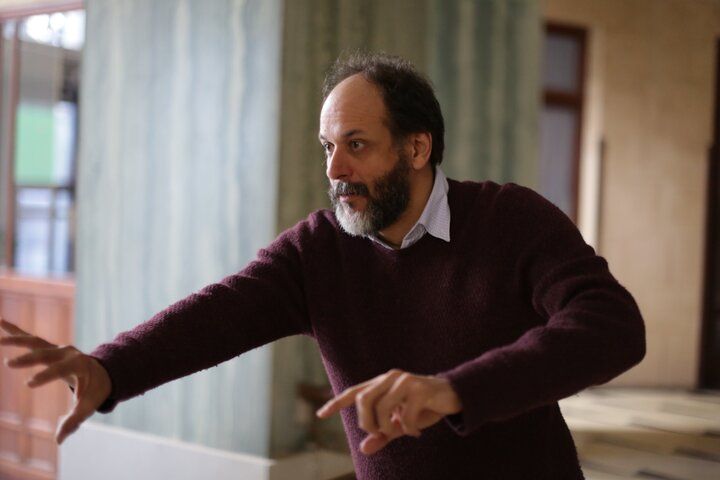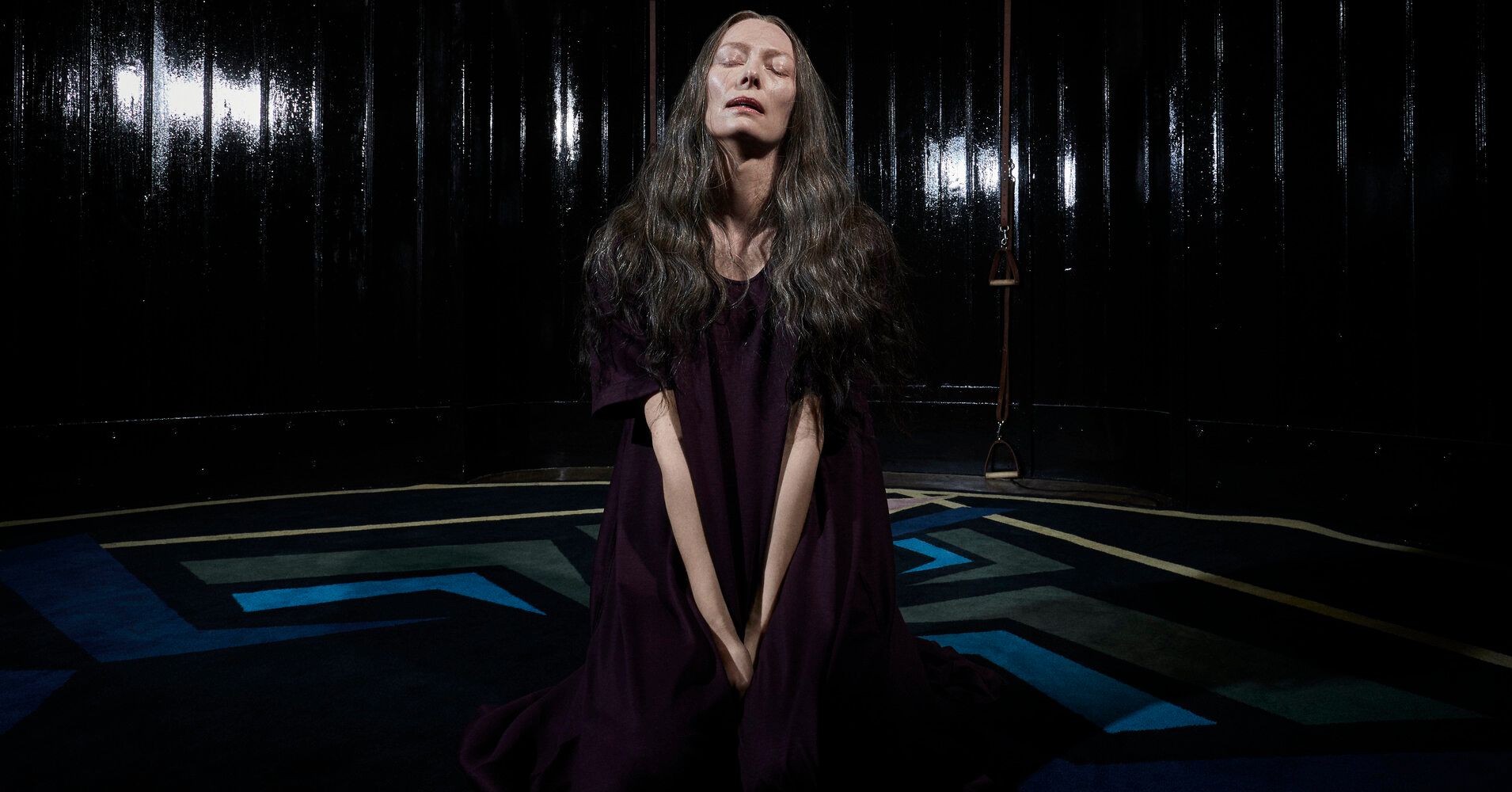[ad_1]
Warning: Spoilers for ‘Suspiria’ below!
About halfway through the bewitching new horror redo “Suspiria,” a shocking image will char its way into your memory. It’s not the dance academy matrons’ spells illuminating walls, nor is it the hooks that pierce a transgressive student’s possessed limbs. The image in question is even more electrifying than the finale’s operatic bloodshed, in which women’s entrails explode and a feeble old man writhes naked on the floor.
I’m talking, of course, about Tilda Swinton eating a chicken wing.
Smack-dab in the center of Luca Guadagnino’s 2.5-hour mood piece, amid the gray skies and grim Cold War politics, there she sits: the regal headmistress herself, Swinton’s Madame Blanc, gnawing on a nub of poultry as if she hasn’t been torpedoing underlings’ lives left and right. It’s the best kind of movie minutiae, a trivial detail so out of place it deserves a life of its own.
The chicken noshing occurs during a conversation with Blanc’s star pupil, Susie Bannon (Dakota Johnson), who aced her audition at the prestigious Berlin school and is scaling the ranks to become the lead in a demanding production that evokes Holocaust brutalities. What Susie doesn’t know ― or does she? ― is that the coven is priming her as a sacrificial lamb. Her true function is to imbue fresh life into Madame Markos, the academy’s decrepit namesake.
Before that can happen, Blanc needs to lull Susie into submission; they must become entwined, psychically and physically. And so they break bread together, sitting opposite each other in a dim room deep inside the institution’s bowels, where the ruling witches convene. It’s Blanc’s private residence, and she’s wearing some sort of nightgown with tulips printed on it. (The original “Suspiria” lacked chicken wings, but it did feature Susie ― or Suzy, as the character’s name was spelled when portrayed by Jessica Harper ― in a crucial tête-à-tête in Blanc’s office.)
After needling Susie over her pallor, Blanc asks about her cloistered Mennonite upbringing. Guadagnino first frames the pair via wide shot, a coffee table separating them. Susie delivers a brief history lesson, explaining that the Mennonites split from the Amish in the 17th century. When the scene cuts closer to them, we see napkins draped across their laps ― a dinner date. Susie appears to be nibbling on shredded white meat, perhaps, but Blanc dares to eat a food item famous for its messiness: Yep, there’s that chicken wing.

The way Swinton wields and bites the wing is fascinating. At first, she holds it in her outstretched arm, propped on the side of the couch where she is seated. Continuing Blanc’s investigation into Susie’s biography, Swinton waves the drumette as she speaks, the rest of her body remaining still.
“How did your journey toward us begin?” Blanc asks.
And then, in closeup, Swinton munches on a chunk of chicken, yanking the bone from her mouth like any wing pro would. Were she a hair less dignified, you’d expect her to set it down and lick her fingers clean.
Of all the foods in the world, and of all the pivotal mentor-mentee meetings that include cuisine, I had to wonder: Why a chicken wing? Something about it seems so … breezy tailgating fiesta? So … ranch dressing? So … Buffalo Wild Wings with a pint stationed nearby? So … Joey Chestnut?
Yet it also feels subversive, like Blanc, despite all her imperiousness, is devouring something that announces itself more loudly than the words drifting from her mouth. She has the chutzpah to brandish a victual that threatens to drench her mouth in sauce, to make her unclean and less formidable. Thank goodness there’s a napkin at arm’s length, not that she puts it to much use.
Longing to get to the bottom of this singular “Suspiria” moment, I emailed the movie’s screenwriter, David Kajganich, who previously penned “The Invasion” and Guadagnino’s “A Bigger Splash” (the latter starring Swinton as a Bowie-inspired rock diva). Kajganich said he consulted Guadagnino and Swinton before answering my questions, though Swinton apparently hadn’t replied to him as of this story’s publication.
“In the script, they were eating some kind of messy Japanese dish, as we’d given Blanc a few fetishes ― being a Japanophile was one of them, girls with brown eyes was another,” Kajganich said. Wanting something less cumbersome but no less distinctive, Guadagnino opted to sub the Japanese entrée with ― you guessed it ― chicken wings.
“Luca chose them,” Kajganich said. “I just emailed him to confirm that, and he said chicken wings were ‘the perfect German food of 1977.’”

Whoa. Who knew? Guadagnino and Kajganich didn’t elaborate, but of course, I then realized, Blanc’s wing may be messy, but it’s not Buffalo messy. That would be far too American for a British sorceress running a Berlin Wall-adjacent company barely a decade after the pub-friendly dish was reportedly invented in upstate New York. (Speaking of 1977, though, the food’s stateside popularity crystallized that year when the town of Buffalo declared July 29 to be Chicken Wing Day. “Suspiria” takes place that autumn.)
As for the wing’s actual flavor, or any potential on-set discussions about how Swinton would consume it, we may never know, unless the actress responds to Kajganich’s queries. (I’ll update this story if I hear anything further.)
One thing “Suspiria” gets especially right: Blanc’s wing is a social lubricant, almost as if it’s a wand ready for incantations. Susie loosens up as their conversation continues, and when Blanc replaces her finished wing with a cigarette, the two really get down to business. That’s when Blanc asks what dancing in the ensemble’s “protagonist” role was like for Susie.
“It felt like what I think it must feel like to fuck,” the repressed Ohio-born student says.
“Do you mean fuck a man?” Blanc asks, seeming to anticipate her answer.
“No, I was thinking of an animal,” Susie counters.
Now, could she utter something so bold had she not watched her teacher ingest a handheld chicken wing with abandon? Could Susie, in the end, have risen to her proper position as Mother Suspiriorum, giver of death and eraser of memories? I think not.
Kajganich signed off his email with another charm: “You can’t imagine how much these questions intrigued us.”
REAL LIFE. REAL NEWS. REAL VOICES.
Help us tell more of the stories that matter from voices that too often remain unheard.
[ad_2]
Source link

